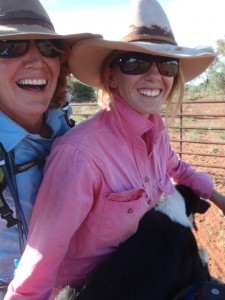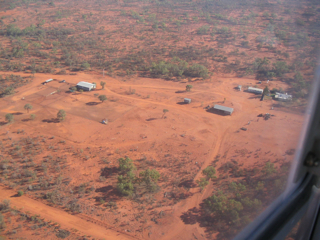Every year a selection of farmers from around the world are chosen to study agriculture and their industry by being sent on a whirlwind tour of the globe. I’ve been lucky enough to be awarded one of these Nuffield Farming scholarships this year and am just about to set out on the experience of a lifetime.

I’m a rangeland goat producer from far north western NSW, my closest town is Wanaaring, home of the Outback Inn and the Wanaaring Wild Goat Muster. My husband Duncan, and two children Matilda and Will moved here at the beginning of 2001 at the start of a severe dry spell with an average rainfall of 5 inches each year from 2001 to 2007. Duncan is long gone, Will is at boarding school and Matilda and I remain, forming the backbone of Princess Pastoral Enterprises.
It’s marginal country, God’s own when it rains and hell on earth when it doesn’t. It’s dominant feature is climatic variability, and it’s that feature that we’ve endeavoured to manage in our business. We don’t talk of drought, it’s either dry or wet, the grass is either growing or it’s not, and thankfully right now the grass is well and truly growing and the place is a sea of green. Lovely!
We manage the climatic variability by matching our stocking rate to rainfall received, might sound simple but to do it well takes a bit of discipline in order to manage the optimist that I believe is inside every farmer.
Our country is fairly scrubby, was once open grassland but has succumbed to invasive native scrub encroachment like so much of the world’s arid country. We can curse the scrub as much as we like but the fact is that its here and nature does nothing without good reason. I see the scrub we have here as nature’s way of building soil to replace what’s been blown away over the years. Soil is built from organic matter and when the palatable grasses are eaten out it makes good sense to me that something would grow that wouldn’t be eaten, would shed leaves and twigs and eventually fall over on top of some bare capped ground where it acted as a nursery for seedlings by trapping wind and water born sand, soil and organic matter. We don’t have to look hard here to see it happening, it’s all around us.
So from a philosophical point of view, we’re endeavouring to work within a natural system rather than against it.
Goats are a great tool for the job, their not real fond of grass but they love to browse, they pull down branches and move quickly through the landscape selectively grazing. But of course they are blamed for a multitude of desertifications simply because they have a strong reluctance to die. When a lot of animals would lay down and die of starvation, a goat will climb a tree to find something to eat, they’ll eat whatever is available in order to survive, and left unmanaged they will totally denude a landscape. I often describe them as being the last man standing in a bar room brawl, just because their still standing and everyone else is out cold doesn’t mean that they caused all the damage surrounding them, just that they are the best survivors.
So, back to the trip, I’ll be studying goat grazing management in arid lands and opportunities for the Australian Rangeland goat industry.
Australia has a feral goat herd of around 2.6 million, harvesters like ourselves take about 1 million off that herd every year, mostly their sold to the US and Asia as cubed goat meat, some are shipped live to Malaysia. Estimates of feral animals in a country as large as Australia are at best guesstimates, but it is thought that the feral goat herd is increasing, their reproductive rate is astounding. I did some rough figures on what one female goat could reproduce over her lifetime calculating the offspring of her female kids and their female kids and so on. I came to the figure of 288 progeny which is entirely unsubstantiated but those of us that know goats would say it was very conservative.
So we better make sure we have a strong market for these goats, and that is part of my study topic. The bane of the rangeland goat industry is a total lack of reward for quality product. It is a commodity based industry only 4 decades old. Rank old billy goat goes into the same box as prime meat. We do nothing to capitalise on our clean, green and wild status, however the upside of that is an extremely simple industry; all we need to do is draft off the animals that are weight, over about 25 kg’s LW and put them on a truck to the abattoir, no husbandry, very little investment and subsequent low levels of risk.
The down side to the industry is the sheer numbers of underweight goats . It would be great to be able to put those animals in a feedlot and finish them off on grain, sell them for a premium and make money at the end of the day, but the profit margin just isn’t there yet, covering costs would be an optimistic budget. Their feral animals, naturally selected for survival traits which aren’t necessarily aligned with the quick growth rates desired by a producer. So inevitably around here those underweight goats get put into goat paddocks where they breed and before long we have more underweights than we have room for and no market for them. That’s a quick justification of my reasoning for the paramount importance of market creation.












